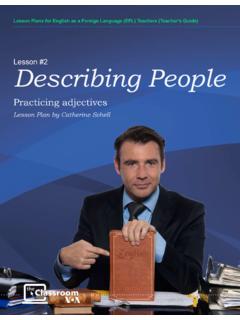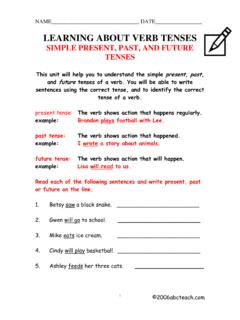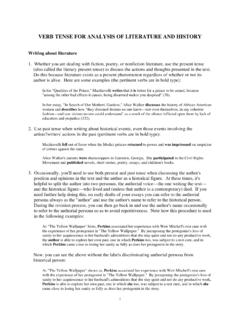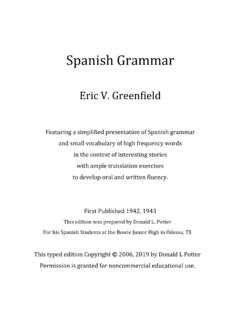Transcription of Lesson #10 Regular verbs: Simple past tense
1 Lesson Plans for English as a Foreign Language (EFL) (Student Edition) Lesson #10 Regular verbs: Simple past tenseLesson Plan by Catherine Schell & Dr. G rard Beck Voice of America s EFL Teaching Community Lesson 10: Page 2 On Facebook: VOA LearningEnglish Learn English with the English Doctor and the English Traveler at Lesson Plans for English as a Foreign Language (EFL) Teachers GuideRegular verbs: Simple past tenseWARM-UP:PASTY esterday Then In 1968, 1991, etc. PRESENTT oday Now In 2011 FUTURET omorrow Then In 2012, etc The goals of this week s Classroom Lesson (#10) are to learn more about the Simple past tense of Regular verbs. In this les-son, you will learn how to recognize and use the Simple past tense of Regular verbs in order to further extend your knowl-edge of verb conjugation in English. You will be able to master this skill through the following text, grammatical explana-tions, and exercises within VOA s The Classroom.
2 Talking about the past:When were you born? I was born in _____ (date)Where were you born? I was born in _____ (city, country)What are the historical events that marked you? Why?Memorable quotes about time: Learn from yesterday, live for today, hope for tomorrow. The important thing is not to stop question-ing. ~ Albert Einstein Life can only be understood backwards, but it must be lived forward. ~ Soren KierkegaardWhat do these quotes mean to you? Lesson Plans for English as a Foreign Language (EFL) Teachers GuideVoice of America s EFL Teaching Community Lesson 10: Page 3 On Facebook: VOA LearningEnglish Learn English with the English Doctor and the English Traveler at Regular verbs: Simple past tenseTEXTSB elow is an edited version of a VOA News article. Read it and underline all the Regular Simple past tenses you can experimented with many new customs and social traditions during the 1920s.
3 There were new danc-es, new kinds of clothes and some of the most imaginative art and writing ever produced in the United States. Many people labeled the period The Roaring Twenties , to show the exuberance and vitality of the artistic and social scenes. But in most ways, the 1920s were a conservative time in American life. Voters elected three conservative Republican presidents: Warren Harding, Calvin Coolidge and Herbert Hoover. And they supported many con-servative social and political policies. Congressman McMillan of Charleston, South Carolina with two women who are doing the Charleston dance near the Capitol building in Washington Most Americans in the 1920s shared some ties through blood or marriage to the first Americans who came from Britain. Many people with these kinds of historic ties considered themselves to be real Americans, true traditionally welcomed newcomers from such western Euro-pean countries as Britain, France, or Germany. But most of the people coming to New York City and other harbors in the 1920s arrived from the central, eastern and southern areas of Europe.
4 Some Americans soon worried about these millions of people arriving at their shores. They wor-ried that the immigrant newcomers might steal their jobs. Or they feared the political beliefs of the immigrants. Pressure to control immigration increased following World War I. Congress passed a bill that set a limit on how many people would be allowed to enter from each foreign country. The nineteen twenties were a time of economic progress for most Americans. During the administrations of President Warren Harding and President Calvin Coolidge, many companies grew larger, creating new jobs. Wages for most Americans increased. Many people began to have enough money to buy new kinds of strong economy also created the right environment for many important changes in the day-to-day social life of Americans. The nineteen twenties are remembered now as an exciting time that historians call the Roaring Twenties. This week in our series, Kay Gallant and Harry Monroe tell more about that period.
5 (MUSIC)Voice of America s EFL Teaching Community Lesson 10: Page 4 On Facebook: VOA LearningEnglish Learn English with the English Doctor and the English Traveler at Lesson Plans for English as a Foreign Language (EFL) Teachers GuideKAY GALLANT: The nineteen twenties brought a feeling of freedom and independence to millions of Ameri-cans, especially young Americans. Young soldiers returned from the world war with new ideas. They had seen a different world in Europe. They had faced death and learned to enjoy the pleasures that each day of these young soldiers were not willing to quietly accept the old traditions of their families and villages when they returned home. Instead, they wanted to try new ways of MONROE: Many young Americans, both men and women, began to challenge some of the traditions of their parents and grandparents. For example, some young women began to experiment with new kinds of clothes.
6 They no longer wore dresses that hid the shape of their bodies. Instead, they wore thinner dresses that uncovered part of their young women began to smoke cigarettes, too. Cigarette production in the United States more than dou-bled in the ten years between nineteen eighteen and nineteen women also began to drink alcohol with men in public for the first time. And they listened together to a popular new kind of music: people danced the Fox Trot, the Charleston, and other new dances. They held one another tightly on the dance floor, instead of dancing far apart.(MUSIC)KAY GALLANT: It was a revolution in social values, at least among some Americans. People openly discussed subjects that their parents and grandparents had kept were popular books and shows about unmarried mothers and about homosexuality. The growing film industry made films about all-night parties between unmarried men and women. And people discussed the new ideas about sex formed by Sigmund Freud and other new important force behind these changes was the growing independence of American women.
7 In nineteen twenty, the nation passed the Nineteenth Amendment to the constitution, which gave women the right to equal importance, many women took jobs during the war and continued working after the troops returned home. Also, new machines freed many of them from spending long hours of work in the home washing clothes, preparing food, and doing other MONROE: Education was another important force behind the social changes of the nineteen-twen-ties. More and more Americans were getting a good education. The number of students attending high school doubled between nineteen twenty and nineteen thirty. Many of the schools now offered new kinds of classes to prepare students for useful at colleges and universities also increased greatly. And colleges offered more classes in such useful subjects as teacher training, engineering, and business inventions also helped cause the social changes. They were the automobile and the radio. The automobile gave millions of Americans the freedom to travel easily to new places.
8 And the radio brought new ideas and experiences into their own the most important force behind social change was the continuing economic growth of the nineteen twenties. Many people had extra money to spend on things other than food, housing, and other basic needs. They could experiment with new products and different ways of living.(MUSIC)KAY GALLANT: Of course, not all Americans were wearing strange new flapper clothes or dancing until early in the morning. Millions of Americans in small towns or rural areas continued to live Simple , quiet lives. Voice of America s EFL Teaching Community Lesson 10: Page 5 On Facebook: VOA LearningEnglish Learn English with the English Doctor and the English Traveler at Lesson Plans for English as a Foreign Language (EFL) Teachers GuideLife was still hard for many people including blacks, foreigners, and other minority many newspaper stories about independent women reporters and doctors also did not represent the real life of the average American woman.
9 Women could vote. But three of every four women still worked at home. Most of the women working outside their homes were from minority groups or foreign films and radio stories about exciting parties and social events were just a dream for millions of Americans. But the dreams were strong. And many Americans -- rich and poor -- followed with great interest each new game, dance, and MONROE: The wide interest in this kind of popular culture was unusually strong during the nineteen twenties. People became extremely interested in exciting court trials, disasters, film actors, and other example, millions of Americans followed the sad story of Floyd Collins, a young man who became trapped while exploring underground. Newsmen reported to the nation as rescue teams searched to find him. Even the New York Times newspaper printed a large story on its front page when rescuers finally discovered the man s dead event that caught public attention was a murder trial in the eastern state of New Jersey in nineteen wrote five million words about this case of a minister found dead with a woman member of his church.
10 Again, the case itself was of little importance from a world news point of view. But it was exciting. And Americans were tired of reading about serious political issues after the bloody world the full article at: of America s EFL Teaching Community Lesson 10: Page 6 On Facebook: VOA LearningEnglish Learn English with the English Doctor and the English Traveler at Lesson Plans for English as a Foreign Language (EFL) Teachers GuideWork on the Text1) List all the Regular verbs that are conjugated in the Simple past ) Can you spot a few other verbs conjugated in the past, which are not Regular ?3) What are the three signs of conservatism during the 1920s?4) Which elements of US culture and history epitomize the 1920s for you?LESSONR egular verbs: Simple past tense The Simple past tense is used to describe actions that are completed in the past. It is formed by adding ed or d to the infinitive of a verb, except for irregular verbs.








